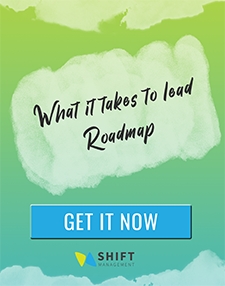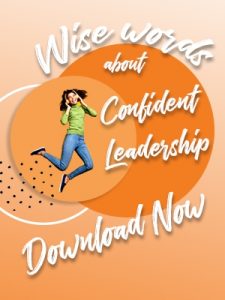Let me tell you a tale of two species…
I was at a conference recently and one of the participants shared this story with me.
“So, I went to the CEO and I said, ‘We have to start learning to stay current in today’s economy.’ The CEO said, ‘Ya, why? I’m making money so why should I change anything?’ I said, ‘When sales go down and you see all the holes, it will be too late to fix things. It’s like trying to fix the hole in the roof during the rain. We should start now. Why don’t we look at some of the industry best practices and have brainstorming session?’ He said, ‘What? Are you trying to teach me something? Get out of my office.’”
Let’s label this story an example of species “I already know whatever matters, this is my empire, and nothing you say is worth listening to.”
Here’s another story. Entire species die if they can’t adapt to changes in the environment.
Polar bears need arctic ice to catch seals. Because of climate change the ice caps in the two poles are melting and seal populations are diminishing. The news has been full of dangerously skinny polar bears helplessly slipping off melting ice because they are unable to catch any seals. BUT all is not lost.
Polar bears, apparently, have decided not to wait for policy-makers to save their habitat and are engaging in new behaviours that have never before been observed in polar bears. They are eating dolphins – species of dolphins they have never eaten before – and burying parts of the dolphin in the ice to eat later. They are eating large amounts of snow geese eggs, seaweed and whale carcasses. And most incredibly, instead of hibernating in the summer, polar bears are coming on shore during the summer months and looking for food on land [1].
Consider the magnitude of these changes: behaviours that have characterized polar bears for probably thousands of years are changing in less than a decade. Polar bears as a group are undergoing a drastic culture change. Why? Because you have to learn to survive. And when you learn, you change. Sustained changes over time become changes to culture.
I’m calling this story an example of the species “We are going to figure this out together or die trying.”
This, my friends, is what business owners have to do to stay current and profitable in a volatile economy.
But maybe you aren’t yet convinced that YOU are the one who needs to do the learning. Yes, YOU – the CEO, COO, CFO, Operations Manager, Regional Director – a person of authority and influence in your organization. YOU have to be the one to make the first learning move, model it for the others, keep on doing it, and get those polar bear employees looking for dolphins, snow geese eggs and land animal food to keep the culture alive. Then you need to listen to what they learned and put it all together into a responsive business model.
Why organizations MUST learn to stay alive
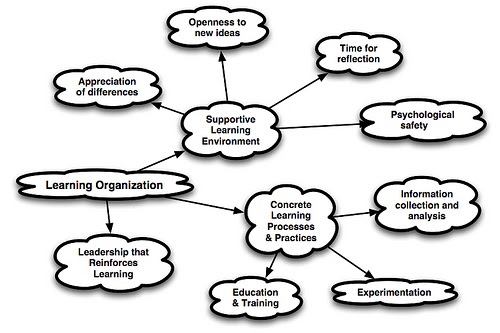
In 2007, David Herrera published a doctoral thesis that examines drivers of market share[2]. To summarize, Herrera studied a large sample of companies using the Nashville Market Share 2004-2006 index and found that Indie market shares started higher at 97%, while major labels and major Indie businesses were in the negatives (-7% and -30% respectively, and remained negative through to the end of year two). Interestingly, however, the Indie market companies took a dive from 97% to 19% in year one, and then went up to whopping 134% in year two.
Percentage of change for Nashville Market Share 2004-2006.
|
Market Share % Change
|
2004-2005
|
2005-2006
|
2004-2006
|
|---|---|---|---|
|
Major Label
|
-7%
|
-3%
|
-9%
|
|
Major Indie
|
-30%
|
-17%
|
-42%
|
|
Indie Market
|
97%
|
19%
|
134%
|
After studying a number of variables, Herrera came up with the explanation that smaller organizations were hungrier to succeed and had greater fears that they would not survive than larger more established labels. As a consequence, like our polar bear friends, they began learning to adapt to the “new normal” environment. They were not successful in the first round because benefiting from mistakes takes learning, experimentation and reflection. But once the LEARNING began and they started to get the hang of things, they sky-rocketed up past all Major and Indie labels in terms of market share.
When diving deeper into the company behaviours that characterized the success, Herrera found several commonalities that were linked to increased market share. They were:
- A climate of learning: Encouragement of continuous learning, integrating new knowledge with the system and modeling of the learning by the company leadership
- A climate of empowerment: Linking learning to performance to market share
- A system to capture learning: Planning for and enabling small units to share knowledge with other small units and then actively building learning connections to overall business objectives.
In brief, all three company categories (Major Label, Indie Label and Indie Market) were faced with the same unfavourable market environment, but only one, the category of learners (Indie Market), were able to make a profit and increase their market share, which is much harder to do.
This was troubling to our then-doctoral student.
“Not if my job is at risk!” – Barriers to organizational learning
After all, if people weren’t a factor, companies could easily implement these three factors into their organizations with a few “blue sky” meetings and a good project manager. However, there are a lot of reasons things are not that easy, a significant one being that fear is a strong motivator for people. Barriers to organizational learning come from individuals who, either from past experience or future prediction, perceive that disadvantages can be significant for those who step away from “tried and true” approaches. New methodologies inject levels of uncertainty into outcomes, and if outcomes are negative, it can affect who gets blamed for deficiencies and who gets laid off.
Herrera went on to examine in more detail some of the reasons larger companies have trouble becoming learning cultures, and he discovered these organizational learning barriers:
- Employees see friends and family losing jobs as a result of downsizing. They hoard what they know to increase their sense of value to the organization
- When the value of employees is based on contacts, relationships and information, there is little incentive to share learning outside of a small, closed circle because sharing is seen to increase vulnerability and risk
- Employees go out of their way to cover up lack of knowledge to avoid appearing incompetent. There is a big discrepancy between what employees say they do and what they actually do. When this becomes the norm, more energy is invested in “covering my butt” than in “learning from my mistakes and moving forward”
- Fear of uncertainty and pain of loss can trigger emotional barriers to learning new things
- Fear of personal repercussions is increased when there is no measurement for gaps in performance or benchmarks for success in performance. Where there is no shared understanding for what constitutes performance, there are no standards and, consequently, no ways to measure progress or decline. It all becomes confused and blurry
- Knowledge from lessons learned by individuals is not shared within the system because there is no way to capture it or to ensure employees will not suffer negative consequences for sharing it
Because intellectual capital is tied largely to the employees of any company, the ability to access this capital is tied directly the the level of voice the employees are willing and able to exercise within the organization. The image below categorizes the differing types of intellectual capital. As you view it, consider how the types of intellectual capital interrelate.
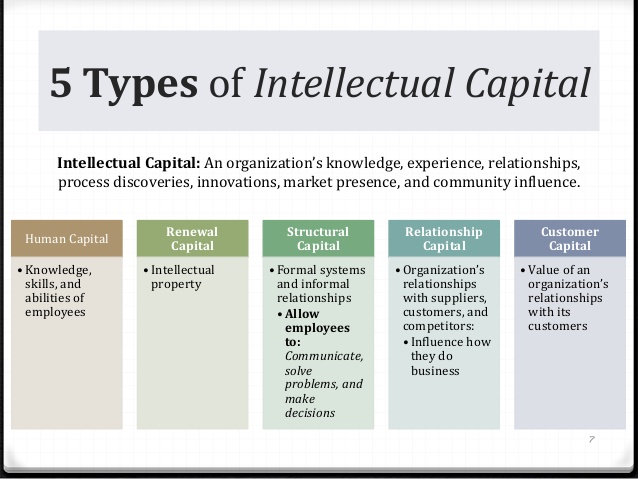
According to Herrera, knowledge constipation – the kind that comes from an individual’s inability to effectively access intellectual capital because the barriers to organization learning are firmly entrenched – leads to a general lack of adaptability towards new technology, unawareness of market trends, lack of ability to respond to market changes and a measureable tendency towards decline in sales year to year. In short, without the free flow of intellectual capital among organization employees, a company puts itself in the path of endangerment, if not extinction.
Modelling organizational learning
From these findings, Herrera moved to find models that explained the learning dimensions of those organizations who were successful and we can all benefit from his findings. One very useful model in understanding how organizations learn is the Watkins and Marsik “7 dimensions of the learning organization.” The summary is below and the free questionnaire is available HERE; it will let you know where your company fits.
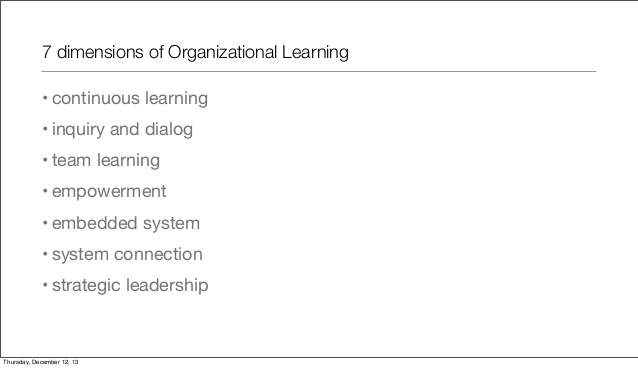
When applied, this model works like this: operations move towards organizational culture and then organizational culture moves towards operations.
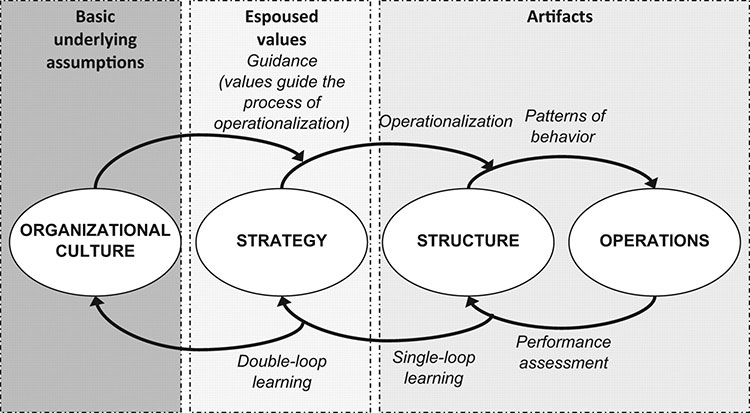
The Watkins and Marsik model is based on Peter Senge’s five learning organization themes [3]:
- Systems thinking: Look at all the components of the system, then gradually acquire the components you need to make the system efficient
- Personal mastery: Each individual commits to the process. No one can be forced to learn, but an environment that encourages learning can be created
- Mental models: Challenge people’s assumptions without making them feel they are inadequate or that they have nothing to use to move beyond the assumptions. Balance the environment with encouragement and challenge
- Shared vision: Long-term goal focus helps everyone center on and continuously recommit to the shared vision.
- Team learning: Learning takes place in a group, uses all the diverse problem solving skills of individual group members to solve a common problem or reach a common goal.
Senges has created a paradigm for considering what a learning organization needs to function effectively:
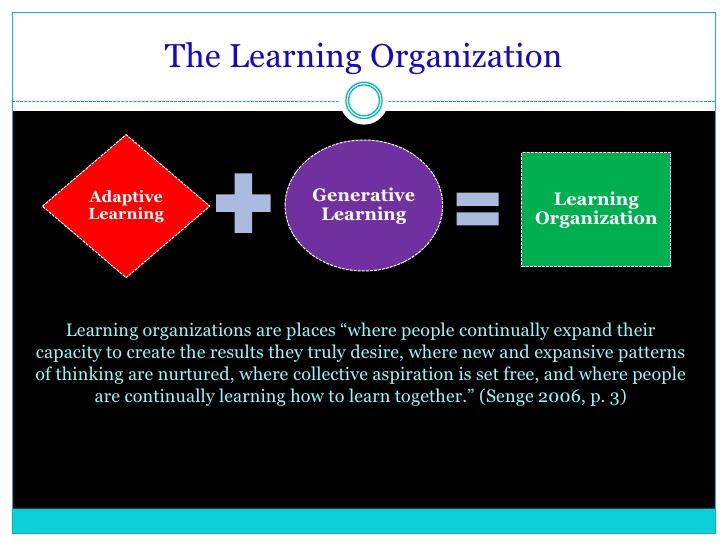
Using this understanding, let’s see how well the polar bears are applying these principles (of course this is my best guess…I’m no polar bear!):
- Bear systems thinking: Polar bears have added four new behaviours to their food finding repertoire
- Bear personal mastery: Each bear who is committed to the process is still alive. Those who haven’t committed may not be. A sobering thought for business owners
- Bear mental models: I’m guessing that no bear puts other bears down for not believing that the ice caps are melting. It did take them awhile to start learning new food-find behaviours though, so it looks like bears have issues with changing their mental models just like humans do
- Bear shared vision: The species is trying to survive and they are “all in” on this project. This gets a “check.”
- Bear team learning: In September 2016 it was all over the international news that a group of bears surrounded a Russian meteorological researcher team and wouldn’t leave until helicopters took the researchers out of the area. Bears are teaming up to take a stand. It looks like this one is also a check mark.
From model to reality
So, you may be saying, “This all sounds great. We have those organizational barriers and the five dimensions of organizational learning make sense, but HOW do WE do it?” Here I invite you to look back to the polar bear example, see how to get started on this organizational learning journey, and commit to moving away from the “I already know everything there is to know” species toward the “We are going to figure this out or die trying” way of thinking.
The truth is that every organization’s situation is unique, and every plan will need to be different. Because it will be your team who is implementing the plan, use your team to build your strategy from the outset. In groups and over a period of time, start by asking yourselves how you can create the two climates and one system that David Herrara outlined for us earlier. Here they are again in question form:
How can our company foster:
- A climate of learning: How can we systemically encourage continuous learning, connect that new knowledge to the existing system, and how can company leadership effectively model our new learning?
- A climate of empowerment: How can we link our learning to organizational performance and how can we connect these to our overall market share?
- A system to capture learning: What do we need to do to create small, information sharing units in our organization? How can we connect these units, and how can we work together to link our learning to our overall business objectives?
It will take more than a “10 tips to more market share” article can cover, but the journey will be worth investing in. Don’t you think we should be able to do at least as well as the polar bears? Are you up for the challenge?
Keep the conversation going!
Talk to us about transforming your company into a learning, empowering system that can respond to market changes and increase market share: email marie@shiftworkplace.com.
Check out our Course Catalogue for online and blended courses for ongoing company learning.
What our customers are saying:
“Great overview, good material and great questions to reflect on. Provided an opportunity to gain more awareness, to step out of our comfort zone and to continue to be more mindful in our workplace…” – Anne Chandler, Accès emploi
“Shift has an incredible ability to assess requirements and are by far, the most exceptional training consultants that I have contracted during my tenure with Alberta Agriculture. Their work resulted in improved productivity in every plant where they provided services. Team building, conflict resolution cultural competency – they are experts in all aspects of these critically important facets of productivity.” – Karen Gingras, The Management Mentor, formerly Alberta Agriculture Retention Manager
“The Shift group brought exceptional knowledge and sensitivity to the project, and despite a limited budget and very tight deadlines, delivered a highly professional program.” – Doretta Thompson, Principal Project Director, Education Services, CPA
References:
[1] Becker, Rachel A. (September 4, 2015) 4 ways polar bears are dealing with climate change. http://news.nationalgeographic.com/2015/09/150904-polar-bears-dolphins-seals-climate-change/
Correct on September 28, 2016.
[2] Herrera, David A. (2007). A Validation of the Learning Organization as a Driver of Performance Improvement, Doctoral Dissertation, Capella University. https://books.google.ca/books/about/A_Validation_of_the_Learning_Organizatio.html?id=Mrz_Dgolip0C&redir_esc=y
Correct on September 28, 2016.
[3] Wikipedia: Learning organizations. https://en.wikipedia.org/wiki/Learning_organization
Correct on September 28, 2016.






